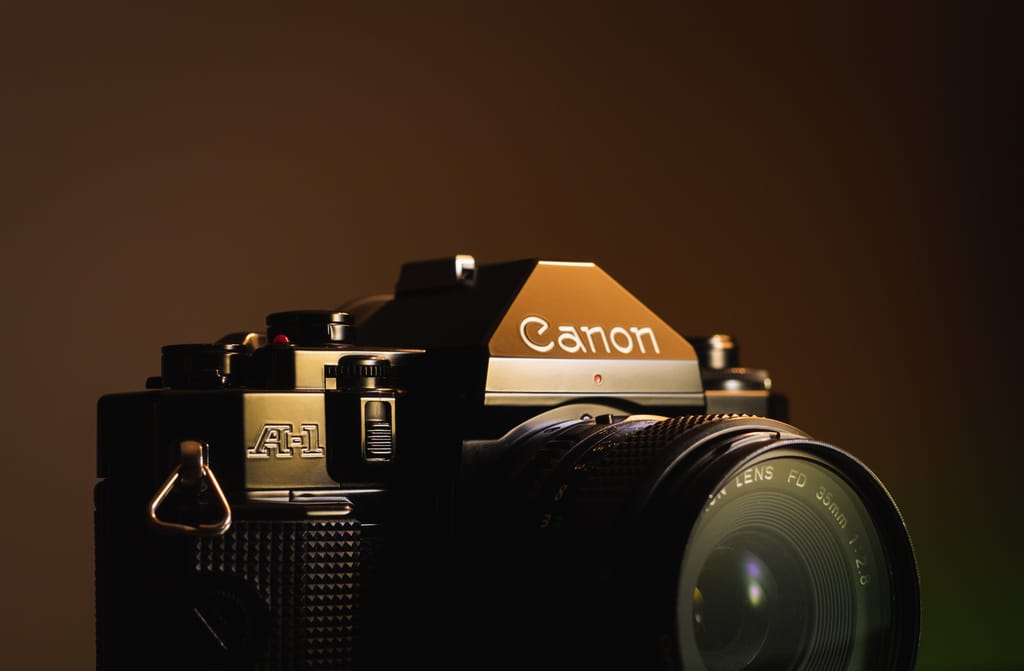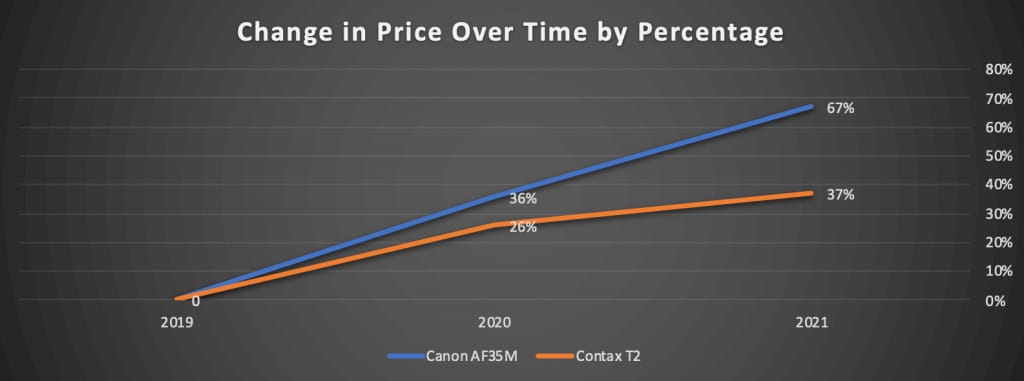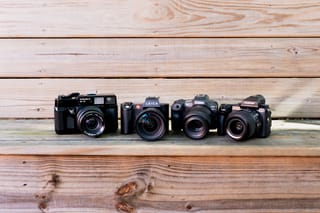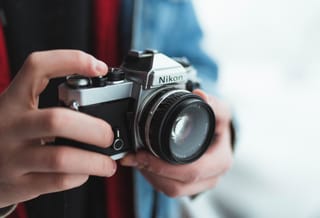
Welcome back to the Tilt-Shift Report, where we share exclusive data and unique insights into the latest trends in camera gear buying, trading and selling.
Last month, we discussed how fast the used mirrorless market has been growing.
This time around, we’ll look at which oft-overlooked film cameras of days past are quickly increasing in value and flying off our shelves.
The Tilt
Looking at the used film camera market as a whole, we can confirm that film gear is having a moment right now.
Over the last couple of years, prices have been on the rise across the board—not just for rarities and collectibles—even ultra-common consumer SLRs and point-and-shoots that were once ubiquitous have been steadily growing in value.
We can partially thank a growing scarcity as these older products age out, but most notably, a world-wide renewed interest in analog photography is the main contributing factor.
This movement is helmed by two groups. The first is comprised of people who shot film before the digital age and perhaps want to recapture that feeling or own some of the gear they grew up shooting. The second is made up of a generation that missed film the first time around. That’s right, people in their teens and twenties are discovering the magic of film for the first time—what’s old is new again.
Honestly, it was just a matter of time before the instant gratification and disposable nature of digital photography was going to face a backlash, and while it’s certainly not a movement sizable enough to revert the industry back to 1985, its impact is certainly felt on the used market.
The Shift
As we know, the analog photography market took a sharp upturn in the last few years. During this time, basically all working film cameras have seen a spike in demand. Trusted brands like Canon and Nikon, whose excellent build-quality and durability have always been a strong selling point, are finding a second, or third, or fourth life.
Take, for example, the Canon A-1.
Manufactured from 1978 to 1985, the A-1 was notably the first SLR to feature Program Mode (P) on the exposure dial. During that time, it sat atop the A line of Canon SLRs, selling for around $400 brand new.
Obviously, after production on the A-1 stopped in 1985, the value of used copies started going down over the next few decades. It actually depreciated more than the mid-level Canon AE-1, even though the A-1 is a better camera in every respect.
For instance, in 2015, you could pick up a fully-functioning, but cosmetically imperfect (what we may consider Bargain-grade) Canon A-1 for about $30-50. Truly a bargain, for a great camera. But those days are no more.
The resurgence of film picked up and hit its stride over the next couple years, and still shows no signs of slowing down.
For example, the value of the Canon A-1 has fully doubled just over the last two years. Bargain-grade units sold for $79 in March of 2019, $129 in March of 2020, and, as of today, they go for around $160.

The auto exposure features of the A-1 are certainly a big factor in its popularity. We’ve seen similar spikes for cameras in its class, like the Olympus OM-4 and the Minolta X700—both increasing in value by around 75% over the last two years.
It makes sense, as these models took the biggest nosedive in value at the dawn of the digital age, so they’ve got the most room to bounce back. They weren’t premium cameras like, say, a Leica M6 TTL or a Hasselblad 503CW, which have maintained their value a whole lot better, even through the lean years.
But what’s important to note is that the A-1, OM-4, and X700 never stopped being capable cameras with a great selection of affordable lenses, so that’s why people are flocking back to them.
They’re finding new life because they’re good entry-level film cameras for someone who maybe has only used a smartphone, or a point-and-shoot digital camera. With these, all you have to do is pull focus, and the camera does the rest of the work for you. Additionally, they can be set for manual exposure, which will help these beginners grow into their gear as they get more experience.
Similarly, we’ve seen a spike for affordable film SLRs that feature autofocus on top of auto exposure. The Canon EOS Elan 7 E, the Canon A2 E, and the Nikon N8008 have all shot up in value by about 80% in the last two years. These mostly plastic SLRs could be picked up for as little as $10 back in 2015, but now fetch for hundreds.
Compacts like the Canon AF35M, the Canon Canonet QL17 GIII, the Olympus XA, and the Olympus Stylus have also seen a jump in price as high as 70% since 2019. The portability and ease of use of these models have made them highly desirable by film shooters on the go.
Again, it’s notable that since these models started off from a lower price point, they’ve grown the most in value. For example, the Contax T2, a premium point-and-shoot which has always maintained its value, has grown by just 37% over the same period, as say, the Canon AF35M, which has jumped up by 67%.

And it’s not only 35mm cameras—some notable medium format cameras have also seen a quick rise in value.
The Mamiya M645 Super, for instance, has increased in value by over 60% in the last two years. Excellent-grade bodies which sold for $149 in March of 2019, are now around $250.
And then there’s items like the hip Mamiya 7 II rangefinder, which has appreciated by about 50% over the same period—an Excellent-grade body goes for around $3,280 today, but could be had on our site for as little as $2,199 just two years ago.
So, what does all this all mean?
Well, for one, if you’re a collector of film camera gear, this is a great time to sell, as demand and buy-back prices are as high as we’ve seen them. But it’s not just a seller’s market—it may also be a good time to invest in film gear since this trend is not letting up. Who knows where we’ll be by this time next year?
Ultimately, as lovers of film photography, we’re thrilled about this resurgence. We love that we get to put great gear into the hands of a whole new generation of creatives that is eager to put it to good use.
As we say around here—keep the good going.




